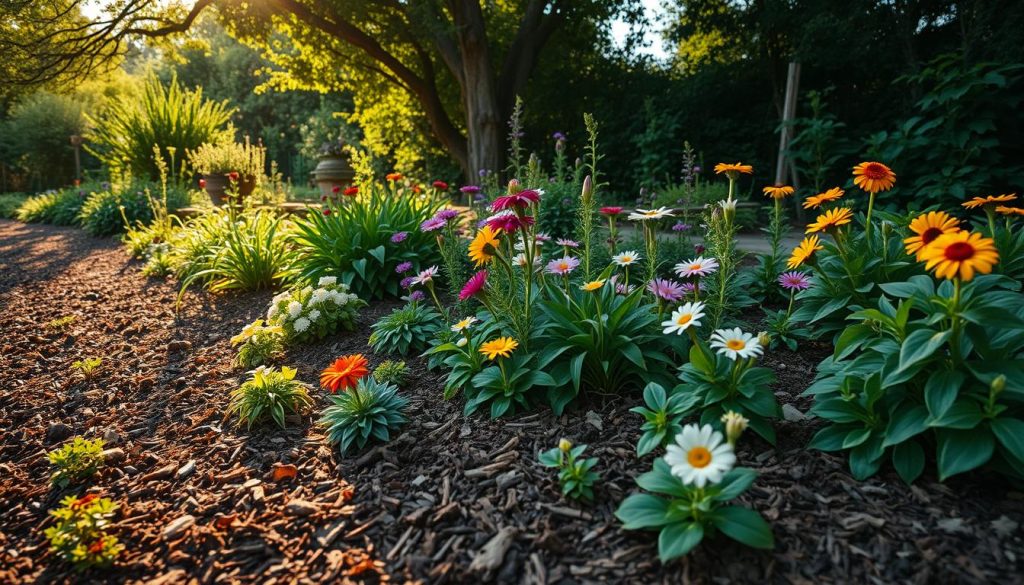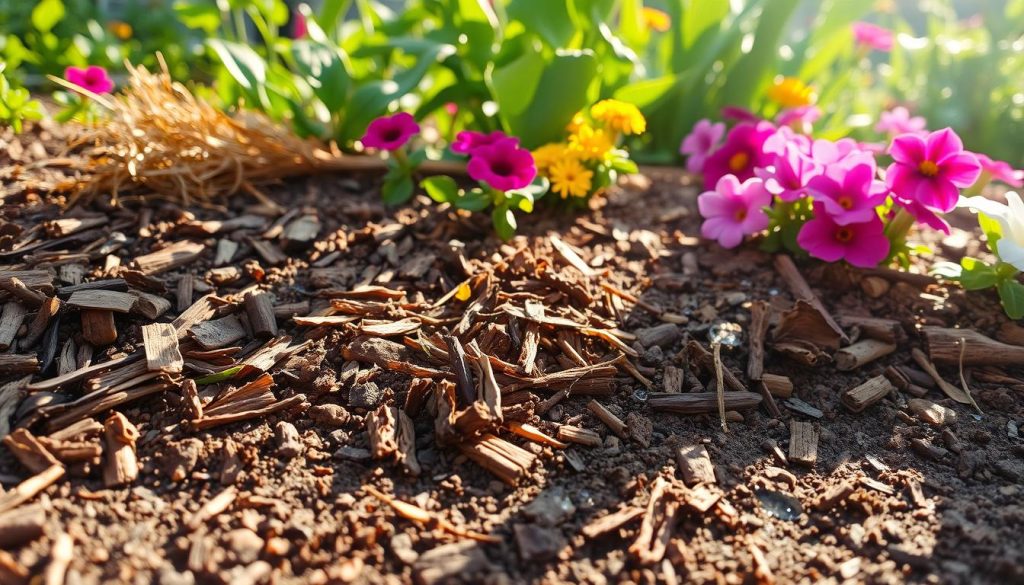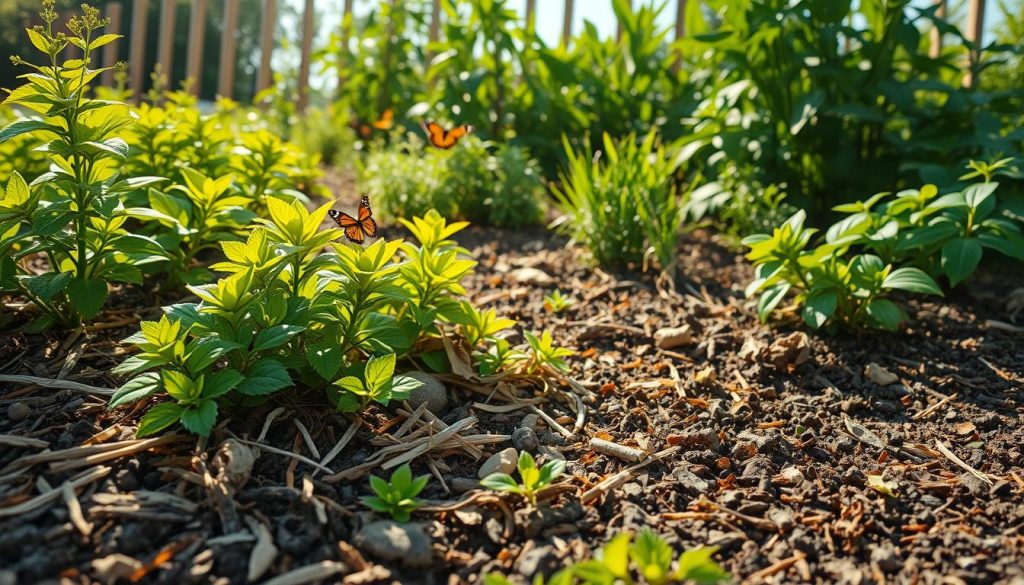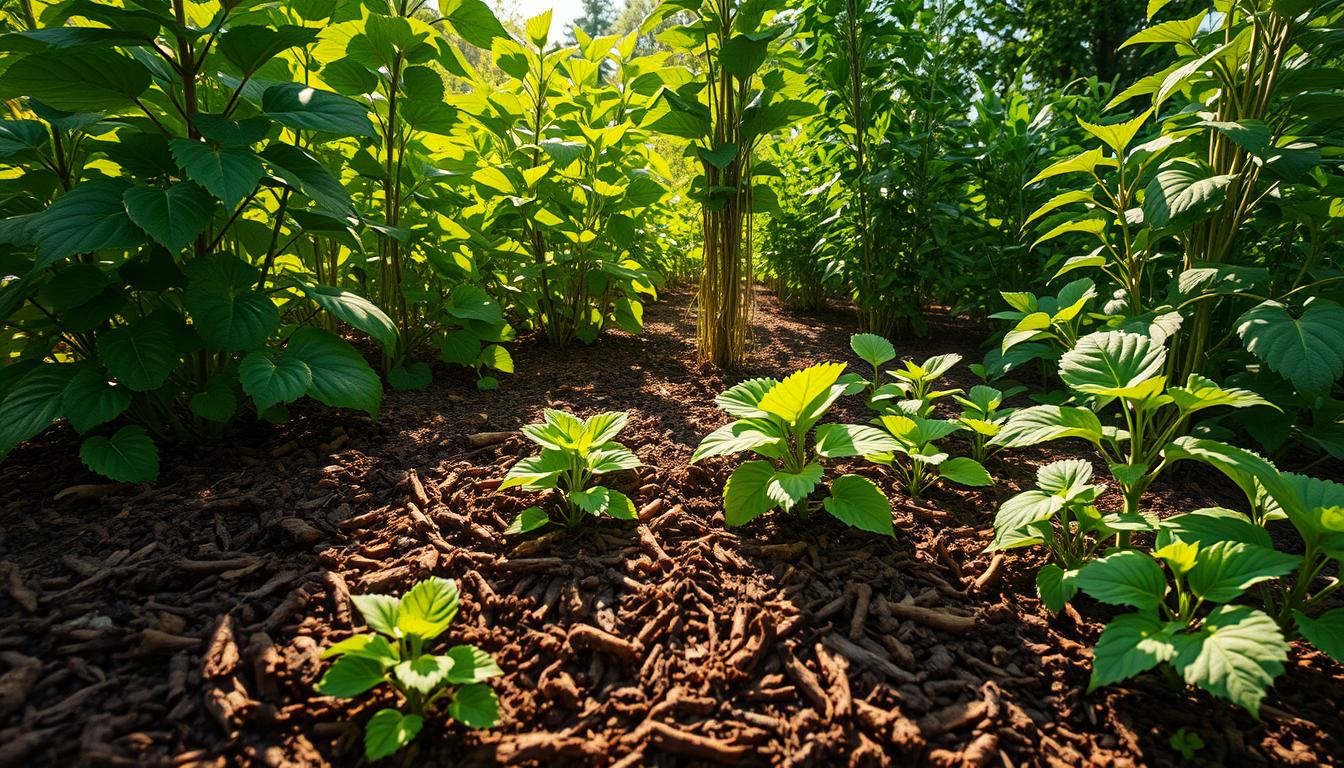As a gardener, I’ve found that mulching saves water. It’s simple and effective. Mulching helps me use less water while keeping my plants healthy.
The benefits of mulching are many. I’ve seen them myself. It helps me save water and reduce my impact on the environment.
Mulching has changed my garden for the better. I’m eager to share what I’ve learned with you. By using mulching techniques, you can use less water and make your garden more sustainable.
In this article, I’ll share my experience with mulching. I’ll also give you tips on how to start using it to save water.
What is Mulching and Why I Use It
Mulching is a simple way to save water and help the garden grow. It involves using organic mulch to keep the soil moist. This method has greatly improved my garden, and I’m eager to share it with you.
I choose organic mulches like wood chips or bark for their moisture retention. They also add nutrients to the soil as they decompose. Plus, they make the garden look beautiful.
Definition of Mulching
Mulching means adding a layer of material to the soil to keep it moist. It also helps control weeds and keeps the soil temperature right. It works well in both home gardens and big landscapes.
Types of Mulch I Prefer
Here are some of my top picks for mulch:
- Wood chips: These are a favorite for mulching and come from different trees.
- Bark: Like wood chips, bark is tough and lasts a long time.
- Leaves: Leaf mold is rich in nutrients and made from composted leaves.
Benefits Beyond Water Conservation
Mulching does more than just save water. It also prevents soil erosion and boosts soil health. By using mulch, I create a healthy environment for plants and animals to thrive.
The Science Behind Mulching for Water Conservation
Mulching is key for gardening in dry times. It helps keep soil moist and is good for the planet. The right mulch and timing are crucial for the best results.
Organic mulches like wood chips or straw keep soil moist. They also help control soil temperature. This is great for plants that don’t like hot or cold weather.
How Mulch Retains Moisture
Mulch keeps soil moist by stopping water from evaporating and running off. This is vital in dry places. It saves water and cuts down on the need for frequent watering.
- Reducing evaporation: Mulch shields soil from sun and wind.
- Preventing runoff: Mulch absorbs water, letting it soak into the soil slowly.
- Improving soil structure: Mulch helps soil hold more water and prevents erosion.

Effects on Soil Temperature
Mulch also affects soil temperature, which is good for plants. It keeps soil temperature stable, helping plants grow better. This is especially helpful in places with very hot or cold weather.
Choosing the Right Mulch for My Garden
When picking the right mulch for my garden, I think about a few key things. I look at both organic and inorganic mulches. Organic mulches, like wood chips, help the soil. Inorganic mulches, like plastic, keep weeds away.
I also think about my climate, soil, and what I like. For example, in wet areas, more mulch keeps the soil moist. But in dry places, less mulch is better to avoid waterlogging.
Factors to Consider When Selecting Mulch
- Climate: Different climates need different mulches to work best, especially for saving water.
- Soil type: The soil in my garden helps pick the right mulch. Some mulches work better on certain soils.
- Personal preference: What looks good and feels right to me also matters when choosing mulch.

By thinking about these points and knowing mulching’s benefits, I can pick the best mulch. This keeps my garden healthy, green, and water-smart. It’s all about using mulch to save water and enjoy its perks.
How I Apply Mulch in My Garden
To make water-saving mulching work, applying mulch right is key. Sustainable gardening with mulch is more than just throwing mulch around. It’s about doing it with care. Before I add mulch, I clean the soil of weeds or debris. This makes the mulch work better and stops weeds from growing up through it.
When applying mulch, I stick to some important steps. Here are a few tips:
- Apply a thin layer of mulch, about 2-3 inches deep, to allow for proper water penetration and airflow.
- Keep the mulch a few inches away from plant stems to prevent rot and disease.
- Replenish the mulch as needed to maintain its effectiveness.

Timing is also key when adding mulch. I usually do it in the spring or fall, when it’s cooler. This helps keep the soil moist. Using water-saving mulching techniques and sustainable gardening with mulch has cut down my water use. It’s made my garden healthier and more vibrant.
Maintaining My Mulched Areas
To keep my garden healthy, I focus on caring for my mulched areas. I check the soil moisture often to avoid dryness or too much water. Mulching helps save water, and I’ve seen great results in my garden.
Keeping the soil moist helps plants grow well and prevents root rot. Here are some tips I follow:
- Check the soil moisture by inserting a finger into the soil up to the knuckle
- Water lightly but frequently to maintain a consistent moisture level
- Adjust my watering schedule based on weather conditions, like rainfall or extreme heat
As mulch breaks down, it’s important to update it. I replace my mulch every 6-12 months, depending on the type and climate. This keeps my garden healthy and saves water.
Monitoring Moisture Levels
It’s key to check soil moisture regularly for a healthy garden. I observe and measure to find the right moisture level for my plants.
When to Refresh or Replace Mulch
Knowing when to update mulch is crucial. I consider climate, soil type, and plant growth to decide when to add new mulch or replace it.
Common Myths About Mulching I Encounter
Exploring mulching, I’ve found many myths that confuse gardeners. One big myth is that only a few types of mulch can hold water. But, I’ve seen many organic mulches that work well too.
Some think a lot of mulch is needed to keep soil moist. But, too much can harm plants. A thin layer can actually work better. Here are some common mulching myths I want to clear up:
Misconceptions About Mulch Thickness
- Too much mulch can suffocate plants and prevent them from receiving adequate oxygen and water.
- A thin layer of mulch can be just as effective at retaining moisture as a thick layer.
- Organic mulch for moisture retention can break down over time, providing nutrients to the soil.
Debunking the Myth of Weeds
Many believe mulch can’t stop weeds. While it’s true mulch won’t stop all weeds, it can help reduce them. By mixing different mulches and good gardening practices, you can fight weeds better.
Real-Life Results: My Experiences with Mulching
I love gardening and have seen how mulching saves water. In my garden, I’ve tried different mulching methods. The results are amazing.
Success Stories in My Garden
One big success is how much less water I use now. I spread organic mulch around my plants. This means I water them less often.
My veggies and flowers do great, even when it’s hot and dry. The mulch keeps the soil moist.
Challenges and What I Learned
Finding the right mulch depth was tough at first. I learned that 2-4 inches is best. It keeps the soil moist but lets it breathe.
I also had to adjust for different plants and soil. But it was all worth it.
Overall, mulching has been a game-changer for me. I hope my story encourages others to try it. It can make a big difference in your garden.

